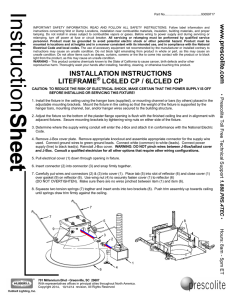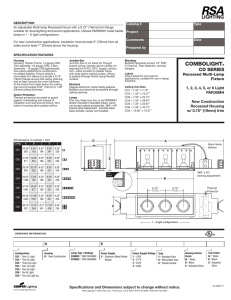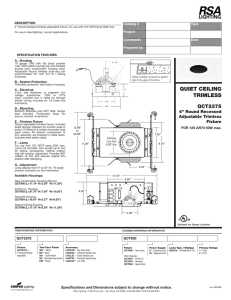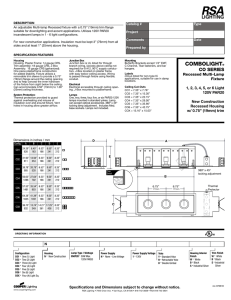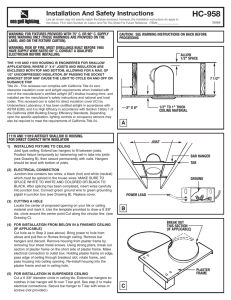Instruction Sheet
advertisement
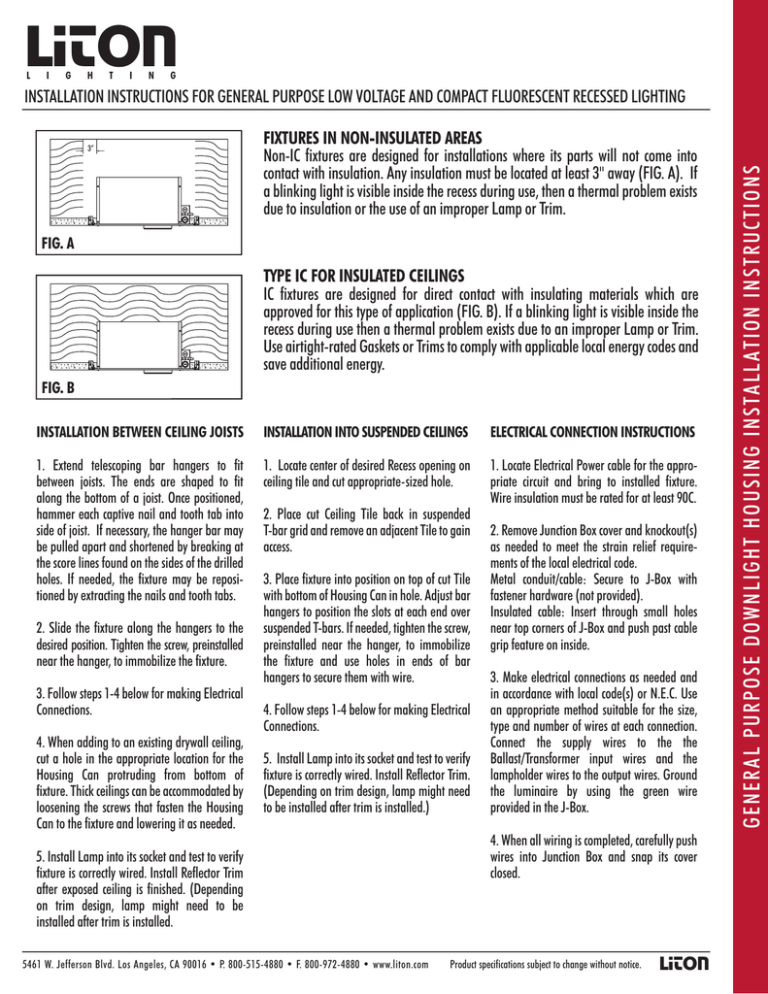
LITON L I G H T I N G 3“ FIXTURES IN NON-INSULATED AREAS Non-IC fixtures are designed for installations where its parts will not come into contact with insulation. Any insulation must be located at least 3" away (FIG. A). If a blinking light is visible inside the recess during use, then a thermal problem exists due to insulation or the use of an improper Lamp or Trim. FIG. A TYPE IC FOR INSULATED CEILINGS IC fixtures are designed for direct contact with insulating materials which are approved for this type of application (FIG. B). If a blinking light is visible inside the recess during use then a thermal problem exists due to an improper Lamp or Trim. Use airtight-rated Gaskets or Trims to comply with applicable local energy codes and save additional energy. FIG. B INSTALLATION BETWEEN CEILING JOISTS INSTALLATION INTO SUSPENDED CEILINGS ELECTRICAL CONNECTION INSTRUCTIONS 1. Extend telescoping bar hangers to fit between joists. The ends are shaped to fit along the bottom of a joist. Once positioned, hammer each captive nail and tooth tab into side of joist. If necessary, the hanger bar may be pulled apart and shortened by breaking at the score lines found on the sides of the drilled holes. If needed, the fixture may be repositioned by extracting the nails and tooth tabs. 1. Locate center of desired Recess opening on ceiling tile and cut appropriate-sized hole. 1. Locate Electrical Power cable for the appropriate circuit and bring to installed fixture. Wire insulation must be rated for at least 90C. 2. Slide the fixture along the hangers to the desired position. Tighten the screw, preinstalled near the hanger, to immobilize the fixture. 3. Follow steps 1-4 below for making Electrical Connections. 4. When adding to an existing drywall ceiling, cut a hole in the appropriate location for the Housing Can protruding from bottom of fixture. Thick ceilings can be accommodated by loosening the screws that fasten the Housing Can to the fixture and lowering it as needed. 2. Place cut Ceiling Tile back in suspended T-bar grid and remove an adjacent Tile to gain access. 3. Place fixture into position on top of cut Tile with bottom of Housing Can in hole. Adjust bar hangers to position the slots at each end over suspended T-bars. If needed, tighten the screw, preinstalled near the hanger, to immobilize the fixture and use holes in ends of bar hangers to secure them with wire. 4. Follow steps 1-4 below for making Electrical Connections. 5. Install Lamp into its socket and test to verify fixture is correctly wired. Install Reflector Trim. (Depending on trim design, lamp might need to be installed after trim is installed.) 5. Install Lamp into its socket and test to verify fixture is correctly wired. Install Reflector Trim after exposed ceiling is finished. (Depending on trim design, lamp might need to be installed after trim is installed. 5461 W. Jefferson Blvd. Los Angeles, CA 90016 • P. 800-515-4880 • F. 800-972-4880 • www.liton.com 2. Remove Junction Box cover and knockout(s) as needed to meet the strain relief requirements of the local electrical code. Metal conduit/cable: Secure to J-Box with fastener hardware (not provided). Insulated cable: Insert through small holes near top corners of J-Box and push past cable grip feature on inside. 3. Make electrical connections as needed and in accordance with local code(s) or N.E.C. Use an appropriate method suitable for the size, type and number of wires at each connection. Connect the supply wires to the the Ballast/Transformer input wires and the lampholder wires to the output wires. Ground the luminaire by using the green wire provided in the J-Box. 4. When all wiring is completed, carefully push wires into Junction Box and snap its cover closed. Product specifications subject to change without notice. LITON G ENERA L PU RPO S E D OW NL I G H T H OU S I NG I NS TA L L AT I O N I N S T RUC T I O N S INSTALLATION INSTRUCTIONS FOR GENERAL PURPOSE LOW VOLTAGE AND COMPACT FLUORESCENT RECESSED LIGHTING
